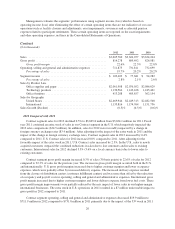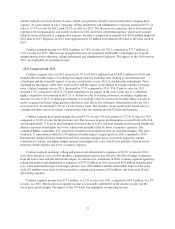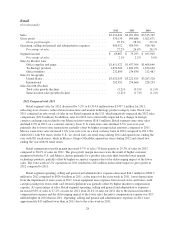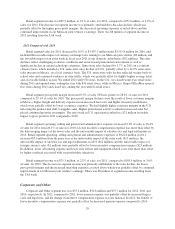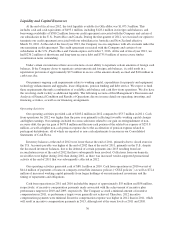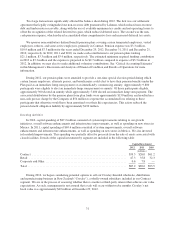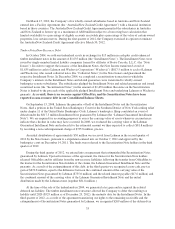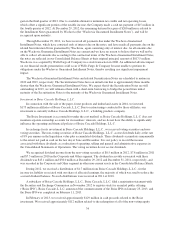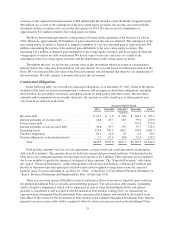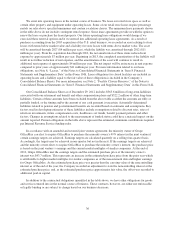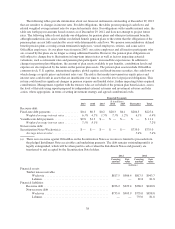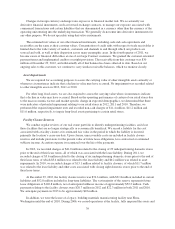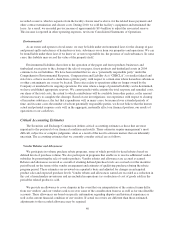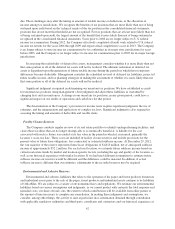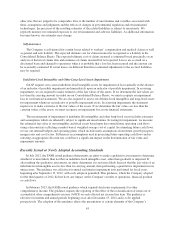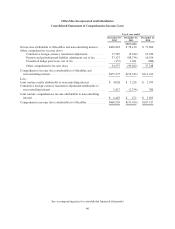OfficeMax 2012 Annual Report Download - page 72
Download and view the complete annual report
Please find page 72 of the 2012 OfficeMax annual report below. You can navigate through the pages in the report by either clicking on the pages listed below, or by using the keyword search tool below to find specific information within the annual report.We enter into operating leases in the normal course of business. We lease our retail store space as well as
certain other property and equipment under operating leases. Some of our retail store leases require percentage
rentals on sales above specified minimums and contain escalation clauses. The minimum lease payments shown
in the table above do not include contingent rental expense. Some lease agreements provide us with the option to
renew the lease or purchase the leased property. Our future operating lease obligations would change if we
exercised these renewal options and if we entered into additional operating lease agreements. As a result of
purchase accounting from the 2003 acquisition of the U.S. retail business, we recorded an asset relating to store
leases with terms below market value and a liability for store leases with terms above market value. The asset
will be amortized through 2027 ($4 million per year), while the liability was amortized through 2012 ($11
million per year). From the acquisition date through 2012, the net amortization of these items reduced rent
expense by approximately $7 million per year. Beginning in 2013, the completed amortization of the liability will
result in no further reduction of rent expense, and the amortization of the asset will continue to result in
additional rent expense of approximately $4 million per year. The net impact will be an increase in rent expense
compared to prior years of approximately $11 million per year. For more information related to our lease
obligations, see Note 8, “Leases,” of the Notes to Consolidated Financial Statements in “Item 8. Financial
Statements and Supplementary Data” in this Form 10-K. Lease obligations for closed facilities are included in
operating leases and a liability equal to the fair value of these obligations is included in the Company’s
Consolidated Balance Sheets. For more information, see Note 2, “Facility Closure Reserves,” of the Notes to
Consolidated Financial Statements in “Item 8. Financial Statements and Supplementary Data” in this Form 10-K.
Our Consolidated Balance Sheet as of December 29, 2012 includes $365.6 million of long-term liabilities
associated with our retirement and benefit and other compensation plans and $322.2 million of other long-term
liabilities. Certain of these amounts have been excluded from the above table as either the amounts are fully or
partially funded, or the timing and/or the amount of any cash payment is uncertain. Actuarially-determined
liabilities related to pension and postretirement benefits are recorded based on estimates and assumptions. Key
factors used in developing estimates of these liabilities include assumptions related to discount rates, rates of
return on investments, future compensation costs, healthcare cost trends, benefit payment patterns and other
factors. Changes in assumptions related to the measurement of funded status could have a material impact on the
amount reported. Pension obligations in the table above represent the estimated, minimum contributions required
per Internal Revenue Service funding rules.
In accordance with an amended and restated joint venture agreement, the minority owner of Grupo
OfficeMax can elect to require OfficeMax to purchase the minority owner’s 49% interest in the joint venture if
certain earnings targets are achieved. Earnings targets are calculated quarterly on a rolling four-quarter basis.
Accordingly, the targets may be achieved in one quarter but not in the next. If the earnings targets are achieved
and the minority owner elects to require OfficeMax to purchase the minority owner’s interest, the purchase price
is based on the joint venture’s earnings and the current market multiples of similar companies. At the end of
2012, Grupo OfficeMax met the earnings targets and the estimated purchase price of the minority owner’s
interest was $43.7 million. This represents an increase in the estimated purchase price from the prior year which
is attributable to higher market multiples for similar companies as of the measurement date and higher earnings
for Grupo OfficeMax. As the estimated purchase price was greater than the carrying value of the noncontrolling
interest as of the end of the year, the Company recorded an adjustment to state the noncontrolling interest at the
estimated purchase price, and, as the estimated purchase price approximates fair value, the offset was recorded to
additional paid-in capital.
In addition to the contractual obligations quantified in the table above, we have other obligations for goods
and services entered into in the normal course of business. These contracts, however, are either not enforceable
or legally binding or are subject to change based on our business decisions.
36


